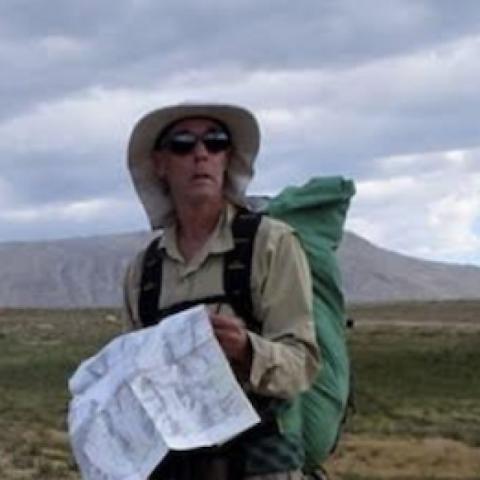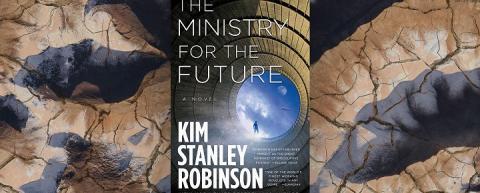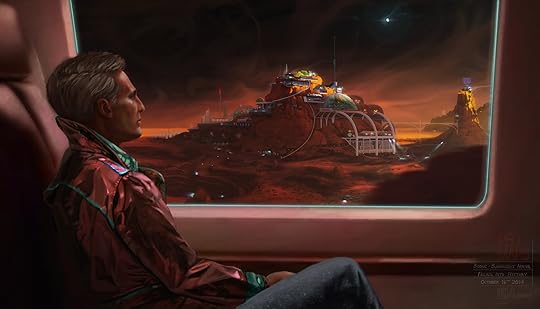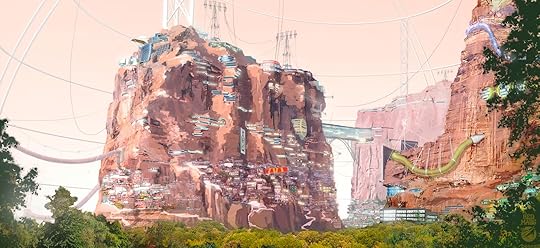Kim Stanley Robinson's Blog, page 2
March 1, 2022
Catching up with Robinson

Some time after the COP26 climate conference in Glasgow in November and some time ahead of The High Sierra: A Love Story book publication in May, let's catch up on all things Kim Stanley Robinson -- mainly around his latest, The Ministry for the Future. And there's been a lot to report!
First, interviews and events.
The New Yorker did an extensive profile on KSR: Can Science Fiction Wake Us Up to Our Climate Reality?
...where KSR, historian Mario Biagioli (behind much of the halp KSR got for Galileo's Dream) and the article writer Joshua Rothman go hiking in the Sierras!
Many of Robinson’s novels are essentially love stories in which friends grow enamored of one another and of the landscapes they explore; I could see that the dynamic was taken from life.
For the Los Angeles Review of Books, Everett Hamner conducted an interview with KSR, where they go in great detail about plot and character of many of his novels: Odd Couples, Carbon Coins, and Narrative Scopes
One change in my thinking came after finishing Red Moon, with the feeling I needed to go right to the heart of the story and not work on the margins any longer. (The moon is particularly marginal.) Another was the very strong impression that if, or when, people suffer a bad enough climate disaster, things will change. Then I began imagining a future history that felt real and yet ended up in some kind of “best case scenario” space — that was my challenge for this project.
Of particular interest to Ministry and its focus on India, KSR was interviewed by Raghu Karnad for The Indian Express: ‘The first to go green will do the best afterwards’
The boldest countries will be the most successful later in the twenty-first century. It can’t be emphasized enough: the first to go green will do the best afterward.
Daniel Aldana Cohen interviewed KSR for Jacobin, a broad and extensive piece well worth a read: Kim Stanley Robinson on Science Fiction and Reclaiming Science for the Left
There’s a category error in thinking that science is just part of capitalism. Calling people “elites” is now a way to attack them. The 1 percent, the people in power, are elites, but are scientists elites? Are university professors elites? Kind of, yes. The word masks a divergence of projects between people who are rich, who want to retain power, and therefore hire lawyers and lobbyists in order to keep their power by killing tax laws, but also experts, scientists, and technocrats who work to make things better.
The term “elites” confuses the issue, demonizing the experts who are absolutely necessary to the work of getting to a better place, as well as the reactionary forces, the people who only want to hold on to their riches for one more generation.
This also resulted into an interview/article at The Guardian: How will humanity endure the climate crisis? -- and an interview at The Dig podcast: Near Futures
KSR was interviewed by the Green European Journal: How We Put Out the Fire
What needs to happen to make this a turning point for the world?
More awareness, more analysis, more flexibility. The creation of working political majorities in all the major economies, towards taking immediate, strong action in coordination with all other nations through the Paris Agreement. Central banks helping to concoct a new political economy in which money is moved away from carbon-burning activities into decarbonisation. All this will need to be led by the people telling their political representatives to do it. Resistance to all nativist authoritarian leaders encouraging tribalism and ignoring the climate problem; these forces are strong, and they need to be defeated.
Chatham House's The World Today magazine included an Interview: Kim Stanley Robinson (subscription required)
Some video interviews:
KSR was interviewed by Vishnu Som for Be INSPiRED, an Indian documentary series by Teamwork Arts: Finding Our Place in the Universe -- about space exploration, his writing about India and more (YouTube video, Facebook video) -- a welcome international outreach for his work.
KSR had the closing keynote at the Boulder Forum on Economy, Climate and Community -- there's a video of event (Vimeo) and a recap.
KSR delivered a lecture to the University of Sydney's Progress in Political Economy: Dodging a Mass Extinction Event: Climate Change and Necessity (YouTube video) -- KSR has been talking about political economy as separate from economics for a while, as far back as the 40/50/60 trilogy and earlier.
KSR spoke at the Berggruen Institute's Possible Worlds series, on Optopia: From Fiction to Action on Climate Change (YouTube video).
More recently, KSR spent an evening with Fossil Free California, where he talked about COP26 and Ministry (YouTube video) -- see also a review of the event.
On for some (audio) podcasts:
On The New Yorker's Politics And More podcast, Kim Stanley Robinson on "Utopian" Science FIction
NPR's Here & Now conducted an interview with KSR: Novelists illustrate the climate futures that could await us (at NPR)
Literature exists to give our lives meaning. It's the stories we tell each other, and literature is the finest stories we have. [...] a kind of realism of our time will become climate fiction by default, because that's the overriding reality of the next few decades and fiction that tries to pretend that it's all about your individual problems without getting to the social and the planetary is a diminished form and not doing its job.
KSR was interviewed by the How We Survive podcast: What Sci-Fi can teach us about the climate crisis
CBC's Ideas podcast: The Best-Case Scenario You Can Still Believe In
KSR was on the Bold.ly Now Show/podcast: Transcending the Climate Crisis with Kim Stanley Robinson (also available as a YouTube video)
...and on the next article we are going to be looking at KSR's trip to COP26 itself.
September 14, 2021
Ministry for the Future around the world

It's easy to think highly of one's self, but we do seem to be living in unprecedented times. KSR's latest novel, The Ministry for the Future, seems to have come at a perfect moment to address the converging crises of our times. Given its urgent and wide subject matter, MftF's readership has spread further than the usual circles of speculative fiction afictionados and into the world of current politics, op-eds, opinion pieces and highly-regarded mainstream media. Here is a glimpse of how this novel impacted the most important discussion of our times.
Announcement: the trade paperback edition of MftF is scheduled to be released on October 19, featuring an all-new cover (pictured above).
First, Kim Stanley Robinson's own articles and writings:
KSR's TED talk (at TEDMonterey): Remembering climate change... a message from the year 2071
Also available on YouTube. This includes a transcript in 8 languages.
The question at that desperate point was: Could things change? [...] Looking back from our perspective 60 years later, this of course looks possible, because they did it. But it was by no means a sure thing. You have to imagine what it felt like at the time, when panic filled the air, and no one could be sure success was even physically possible.
KSR's article on the Financial Times: A climate plan for a world in flames
What does it feel like to live on the brink of a vast historical change? It feels like now.
(+ a reader letter on that: The young will need resilience to cope with a dystopian future)
KSR's article on The Washington Post: A declining world population isn’t a looming catastrophe. It could actually bring some good.
In other words, the precarity and immiseration of the unemployed would disappear as everyone had access to work that gave them an income and dignity and meaning (one new career category: restoring and repairing wildlands and habitat corridors for our cousin species), but this would still be a bad thing for the economy. The economy, measured by profit, being the most important thing. More important than people.
KSR's article on The Nation: The Novel Solutions of Utopian Fiction
Utopias exist to remind us that there could be a better social order than the one we are in. Our present system is the result of a centuries-old power struggle, and it is devastating people and the biosphere. We must change it—and fast.
KSR's article on Bloomberg Green: The City as a Survival Mechanism
What we’ll ask of cities in the climate era includes many contradictions, even some double binds. The climate city will need to be compact but with green space. It will have to be energy-efficient but also home to a great deal of industrial production. Instead of being carbon hot spots, belching out emissions, it would be better if cities were carbon-neutral heat sinks, helping to cool the planet. And while a good deal of agriculture and even animal husbandry should take place in cities, to help empty more of the country, our urban spaces should also feel pleasant and parklike for their human inhabitants.
Second, interviews. New interviews are so many, I will just list them here, chronologically, March to August:
Warm Regards podcast: Building our Climate Futures Through Storytelling, with Eric Holthaus + Kim Stanley RobinsonWPKN Digging in the Dirt Radio WREK Lost in the Tracks Radio (direct link)Resilience What Possibly Go Right? PodcastLitHub's Amy Brady: How Contemporary Novelists Are Confronting Climate Collapse in Fiction: a Roundtable with Omar El Akkad, John Lanchester, Lydia Millet, Kim Stanley Robinson, Pitchaya Sudbanthad, Madeleine Watts, and Diane Wilson: part 1 + part 2The Climate Pod (podcast)Money on the Left podcastOpen Book on Location: Kim Stanley Robinson and Barbara Kingsolver (video)Planetary Regeneration podcastBuilding the Dream podcastThe New Yorker: Is Mars Ours? (exceptionally, this one is not about MftF but about the Mars trilogy!)KQED: Imagining a Not So Grim Post-Apocalyptic Future with Writers Kim Stanley Robinson and Annalee NewitzThe New York Times: What if American Democracy Fails the Climate Crisis? (Ezra Klein interviews Saul Griffith, Rhiana Gunn-Wright, Sheila Jasanoff, Kim Stanley Robinson)The Economist: The World Ahead: The growing risk of deadly heatwaves (podcast)Harvard Business Review: Imagining Climate Futures with Kim Stanley Robinson (podcast)Slate: Future Tense: I Can’t Stop Thinking About the First Chapter of This Climate Change Novel The New Yorker Radio Hour: Reading About Climate Change as the Summer Gets HotterTime: "You Need to Use Hope like a Club to Beat Your Opponent."
Third, reviews of MftF:
Gabriel Carlyle in Peace NewsNick Foster in We Know ZeroPeter Berard in Dig BostonGareth Watkins in the Los Angeles Review of Books (along with two other books)Todd TuckerDavid Schwartzman in the Washington SocialistAshish Kothari in Mongabay (India)Dan Dinello in Informed Comment (also here)Oliver ArditiJavier Sethness Castro in the Institute for Anarchist StudiesDavid Zetland in The one-handed economistMark Heywood in the Maverick Citizen (South Africa)George Katsiaficas in Counter PunchAvery Davis Lamb in Sojourners (paywall - print/online magazine, August 2021 issue)Vincent J. Miller in America: The Jesuit ReviewPat Kane in The National (Scotland)Lynn Fitz-Hugh in Yes! Magazine
But that's not just it. Plenty of readers have taken MftF and ran with it, referring to it to build a case or as as source of inspiration, and more:
This LA Progressive article starts from MftF to imagine a Ministry of Climate ModificationThis Popular Science article on carbon coins refers to MftFKSR's various op-eds are discussed in an article on the new era of climate journalismAndreas Malm, author of How To Blow Up A Pipeline that KSR has referred to, refers to MftF in turn in his response on Verso BooksThe Guardian on climate optimismDeanna K Kreisel in Public Books uses MftF alongside two other recent books, by Bill Gates and Ailton Krenak, to discuss utopia, optimism and realismInspired by MftF, on planting urban forestsBill McKibben in The New Yorker on slowing down after the pandemicDerrick O'Keefe on the 2021 British Columbia heat waveLos Angeles Times on climate fictionThe climate crisis as seen from the city of Duluth, MinnesotaEliza Daley in Resilience.org muses on Baram's claim "we need a new religion"Bianca Wylie, on the acceptable field of discourse of solutionsIn addition, these sites include MftF in recommendations and reading lists: Street Roots, Foreign Policy, Politico, Community read-along in Decorah, Iowa. Also, bestsellers lists.
Finally, MftF was a finalist for the 2021 Locus Award for Best SF Novel and for the 2020 Kitschies Award (awarded for "the year’s most progressive, intelligent and entertaining fiction that contain elements of the speculative or fantastic").
This is the end of the links lists...for now. Coming up in the fall: KSR will be at the UNFCCC COP in Glasgow!
March 1, 2021
Ministering for The Ministry for the Future

KSR's The Ministry for the Future has been out and has been making waves -- yes, Covd-19 was not a thing when it was being written but that doesn't mean that this near-term SF novel is not the most topical thing you are likely to read this year!
(Featured image: working on installing infrastructure, from FDR's Civilian Conservation Corps as part of the New Deal -- inspiration for Biden's announced Civilian Climate Corps Initiative.)
Ministry has been nominated for the British Science Fiction Association (BSFA) Awards for Best Novel!
Ministry made it onto the best sellers list of Southern California’s Independent Booksellers Alliance (Feb 7, 2021) and the Pacific Northwest Booksellers Association (Feb 14, 2021).
After covering Ministry in detail, Matt & Hilary were joined in their Marooned! on Mars podcast by KSR in a long, detailed and pleasant interview. A must! Listen to it here, and below:
Also, Bryan Alexander's book club of Ministry continued and wrapped up: Part 3, Part 4, Part 5.
The pandemic has had the positive effect of a plethora of audio/video interviews and free online events with KSR taking place! All I can do is just list them. Here are all the recent ones:
WILL (NPR Illinois): Brian Mackey and Ryan Andrew Wilde interview KSRNew Books in Science Fiction: Rob Wolf interviews KSRSingularity Weblog: Nikola Danalyov interviews KSR (a lengthy one, 2h20!)Oregon State University's Pandemic as Portal: Creating a Just Future on Earth: Kim Stanley Robinson presents "Some Lessons from the Pandemic for Dealing with Climate Change"Bioneers.org: J.P. Harpignies interviews KSR (includes transcript)Pod Damn America: The Agony Column / Narrative Species: Rick Kleffel interviews KSRAnarres Project for Alternative Futures: Bridge Toward Utopia: Kim Stanley Robinson with Joseph Orosco and Tony VogtRevolutionary Left Radio: KSR interviewAksioma: (re)programming: Strategies for Self-Renewal: "Trigger: What does it take to change the future?" Curated by Marta Peirano with special guests Lučka Kajfež Bogataj, Luka Omladič, Ida Hiršenfelder (beepblip)Reversing Climate Change: KSR with NoriOutrage + Optimism (Global Optimism): KSR interviewed by Christiana Figueres (ex-UNFCCC Sec Gen!), Tom Rivett-Carnac and Paul Dickinson (includes transcript)Climate One: Climate Narratives with Elizabeth Kolbert, Kim Stanley Robinson and Jeff Biggers (includes transcript)In addition, the KSR interview by Eliot Peper we linked to earlier has been reprinted in OneZero: Inventing Plausible Utopias.
Now for the list of reviews of Ministry:
FeydRautha in L'épaule d'Orion (French)Gromovar in Quoi de neuf sur ma pile? (French)Bryan Walsh in AxiosStephen Saperstein Frug in Ancillary Review of BooksSam Roggeveen in The Interpreter (Lowy Institute, Australia)David Gorin in Business Live (South Africa)The Morning Star OnlineDiane Adams in International Falls JournalThe Void That BindsKarin Pettersson in Social Europe (also on IPS Journal)Eric Morales-Franceschini in Tropics of MetaGwen Ansell in New FrameJo Lindsay Walton's blogSamuel Miller McDonald's review/criticism in Current AffairsPhil Christman at Plough.comNick Robins for Grantham Research Institute / LSELaureen Fagan in Sustainability TimesEddie Playfair's blogFelicity Harley in Medium.comTanya Hawkes's blogGabriel Carlyle in Peace NewsJustin Reynolds in SPE Review London (Society of Petroleum Engineers) (in print, also available online)Orange Coast (in print, March 2021)Ministry was also in some Best of 2020 lists, namedumps and 2021 recommendations:
Muhammad Omar Iftikhar in Daily Times (Pakistan)Orange County Library SystemMusician Conor Bourgal recomments Ministry in MoMAArizona State University president Michael M. Crow recommends Ministry in Zocalo Public SquareLocus Magazine: in Jonathan Strahan's 2020 Staff Picks, Graham Sleight's 2020 Year in Review, and in the consensus article on the 2020 Recommended Reading List"5 books to raise your climate consciousness in 2021": David Charles in Landscape NewsMalta's Minister for the Environment and Climate Change Aaron Farrugia (Lovin Malta)Tucson Festival of Books recommends Ministry (Tucson.com)Finally, KSR's works and Ministry get mentioned often in articles, taking a particular aspect of the novel and running with it. For instance:
In Jacobin: "How Sci-Fi Shaped Socialism" -- From William Morris to Ursula K. Le Guin and Iain M. Banks and KSRIn the context of Bill Gates' recently published book on the challenge of climate change (GreenBiz, MIT Tehnology Review Wet bulb temperature and carbon taxes (The Community Word)Carbon coin (Chris Taylor in Mashable), with quotes from Stand and Delton Chen (of "the Chen paper" fame)Geoengineering (Bill McKibben in The New Yorker)Tragedy of the time horizon and space colonization (Vidvuds Beldavs in The Space Review)A new Ministry for the Future-like organisation in New Zealand, the Climate Change Commission (Otago Daily News)The (non-)topicality of disaster movies (The New York Times)Modern Monetary Theory (The New Republic) That's an impressive list of bullet points! Check out the calendar for announced and identified events. And keep on reading and surviving, till next time!December 18, 2020
Rooting for The Ministry for the Future

2020 would have been the year of two very important United Nations Conventions of Parties, one by the Convention on Biological Diversity and one by the Framework Convenion on Climate Change, five years after the landmark Paris Agreement; both have been pushed to 2021 because of Covid-19. As 2020 draws to a close, civilization again starts looking beyond the short-term crisis into the wider and longer-term threat of climate change and biodiversity loss. And Kim Stanley Robinson's The Ministry for the Future is there to synthesize the issue, make us feel interconnected, and make us envision a pathway to a better world.
(Image: KSR, from LARB.)
Stan's regular column for Bloomberg Green continues, with "Slowing Climate Change With Sewage Treatment for the Skies", about biological and technological ways to suck carbon from the air:
The problem isn’t technical viability but the giant investment required to build something that may not yield a profit. There’s promise in developing liquid fuels made with captured CO₂ or turning the primary greenhouse gas into feedstock for various carbon fibers. But the amount of carbon we need to draw down far exceeds these industrial uses, and capital seeking the highest rate of return won’t get invested.
KSR's interview with Ezra Klein at Vox is a must-listen! Klein calls Ministry "The most important book I’ve read this year" and their conversation goes to the crux of Robinson's thinking and the significance of his work for literature and positive change. Klein summarizes:
This conversation with Robinson was fantastic. We discuss why the end of the world is easier to imagine than the end of capitalism; how changes to the biosphere will force humanity to rethink capitalism, borders, terrorism, and currency; the influence of eco-Marxism on Robinson’s thinking; how existing power relationships define the boundaries of what is considered violence; why science fiction as a discipline is particularly suited to grapple with climate change; what a complete rethinking of the global economic system could look like; why Robinson thinks geoengineering needs to be on the table; the vastly underrated importance of the Paris climate agreement, and much more.
Everett Hamner conducted an extensive interview with KSR for the Los Angeles Review of Books: "Odd Couples, Carbon Coins, and Narrative Scopes". How to insititue change, the role of violence, the source of recurring character names in KSR's novels (like Frank or Charlotte), autobiographical parts in Green Earth, narrative modes, the narcissism of small differences in politics, the balance of power between politics and banks and money, religion, and more are discussed in a vivid intellectual back and forth. A small sample:
One change in my thinking came after finishing Red Moon, with the feeling I needed to go right to the heart of the story and not work on the margins any longer. (The moon is particularly marginal.) Another was the very strong impression that if, or when, people suffer a bad enough climate disaster, things will change. Then I began imagining a future history that felt real and yet ended up in some kind of “best case scenario” space — that was my challenge for this project. Then it seemed inevitable that chaos and violence were going to be part of the story. If I sometimes thought of it as a coming revolution, it still seemed clear it was also going to be a giant mess — all kinds of different revolutions at once, adding up to a violent set of spasms out of anyone’s control — something like Williams’s “long revolution,” narrated as a slurry. That struck me as accurate to how even a best-case scenario would play out, and it was also a formal challenge and opportunity, for game-playing in the novel as formal construct.
[...] Money is a public utility, banks are badly run credit unions, a nationalized bank system would make money into something you get access to for a fee that you pay to the public treasury — and so on, like that. This sounds weird until you reflect it’s almost like that already; it’s just been mystified by predatory rent-seekers pretending things are different in such a plausible way that current legislation tends to skew toward their interpretation of these large structures. Finance has been made so complicated that legislators turn to financiers to craft financial legislation, because the legislators are scared they don’t understand it. But good financial advice can come from the left as well as the right, and ultimately it’s still very simple — a power dynamic. And people seizing power from a privileged minority is the long arc of history. A better story changes politics, then laws.
[...] I’m interested in the Ur-religion of shamanism, which is probably over a hundred thousand years old, and came out of Africa when people did; and in all the ones you listed above, Buddhism in particular. And then also science as a kind of devotional practice that regards the real as a sacred object of study; isn’t that a religion? And when I’m in the Sierras I often feel something ineffable, some kind of holiness. I think almost everyone has these feelings, and not having them would be bad; it would constitute a kind of lack or crisis.
KSR was also interviewed by Rolling Stone! The result is a fast interview with much shorter sentences than the previous interview: "What Will the World Look Like in 30 Years? Sci-fi Author Kim Stanley Robinson Takes Us There". Select bits:
I am a leftist, an American leftist, and I’m saying just as a practicality that overthrowing capitalism is too messy, too much blowback, and too lengthy of a process. We’ve got a nation-state system and a financial order, and we’ve got a crisis that has to be dealt with in the next 10 to 20 years. So I’m looking at the tools at hand. Tax structures, sure. And essentially, I’m talking about a stepwise reform that after enough steps have been taken, you get to something that is truly post-capitalist that might take huge elements from the standard socialist techniques.
I love the Green New Deal. I love HR109 [the Green New Deal resolution introduced by Rep. Alexandria Ocasio-Cortez]. That’s really a smart document. It’s not naïve. It’s not primitive. It’s a fully articulated plan that takes in a lot of social elements that are very smartly done. So this is not a naïve crowd. There’s something hubristic about the phrase geoengineering, and it looks like a Silicon Valley techno silver-bullet fix that is against the grain of the total program that the left is insisting on, which I totally agree with.
In another interview for The Nation, "Kim Stanley Robinson Bears Witness to Our Climate Futures", Stan talks about California fires, the Coronavirus pandemic, Black Lives Matter, and more. Select bits:
[On work and laboring in his novels] I think the right to work, the dignity to work, and the idea that it’s actually bad not to have work is a post-Marx or 20th century development. The bourgeois novel is famous for not being able to write about work because it’s too boring. The story of work is the repetition of things that ultimately go right, and only when things go wrong do you have a plot. The novel isn’t well suited to describe the repetition and the interests of work per se. In Red Mars, the idea of building a town has drama to it because it’s on an inhospitable new planet; the work can be described and be of interest as a plot. In Ministry for the Future, the work is everybody shifting their lives to decarbonization, and the technocracy of the ministry itself as a form of work. We’re all working on the project, part of the machine.
[On animal rights] For a long time, it’s been a very vexed topic for me. I’d say that there was a split on the left between environmentalists and human-centric leftists. The one side seemed to regard nature as just the raw material for humans, and that was incredibly anthropocentric, and the other was often accused of being a bourgeois ideology of people comfortable enough to worry about the natural world and the whales. So, on that divide I was always a green, but it seemed to me as a leftist, the two were the same. People talk about the European greens having red roots or there’s watermelon people who are green on the outside but red on the inside. This is to create a distinction that is just a bad split of two forms of anti-capitalism. And when you regard nature as our extended bodies, the first biosphere is the human being. For either to thrive, both have to thrive. Certainly for humans to thrive, the biosphere has to thrive.
Hightech/Highsnobiety has an original interview with KSR, a "Rorschach test of subjects to pontificate on", where KSR responds to key words: "The Science Fiction of Right Now". Sample:
California
My home state is a strange place. It’s some kind of culmination to American history, in that many people kept moving west until they had to stop. And where they stopped was a very unusual landscape with a great amount and variety of terrains and climates. A biological hot spot, even though it doesn’t have much water compared to places with more rainfall and what would be needed to supply the needs of its almost 40 million people. Its water is distributed around the state by way of a system, so you could say it’s a terraformed space.
Add to that a very strange history, including the original gold rush, Hollywood’s movie industry, and Silicon Valley’s computer industry — these combine to make for a freakish place, a magical name and idea in world history. Possibly all these blessings add up to a curse, but at least California will always have its Sierra Nevada, one of the great mountain ranges of the world and one of my favorite places to be.
Slate has a summary of New America event on November 10, with bits from KSR, Peter Schlosser (ASU) and Malka Older (SF author), "Imaging a “Future of Opportunity”—and Governing Toward It":
And to do so, said Robinson, we have to get creative in the ways we imagine and share our blueprints for the future.
“If storytelling itself is going to be adequate to this global situation that is beyond any one individuals’ comprehension,” he said, “then you have to just throw caution to the wind and try to make up new forms and tell stories that actually reflect this dynamic moment that we’re in.”
The December 2020 print edition of Locus has an interview with KSR: "Forward the Future". Some excerpts are available online:
Most of what I wrote about in The Ministry for the Future is already out there in the world. I did very little extrapolating of technology. The book’s plan for slowing down Antarctic glaciers is the idea of an individual glaciologist who shared it with me, telling me he didn’t want to talk in public about it because he didn’t want to get dragged into the geoengineering wars. [...] The other important part of my plot, the carbon coin, comes out of a paper I ran into online, by Delton Chen.
Two more video interviews in this prolific time:
KSR with Christopher Tucker (of the American Geographical Society) for Geography 2050.
KSR with Josh Fox for The Young Turks.
Book excerpt! Regen Network, an effort to align economics with carbon drowdown in land management (and on whose real-world work the list of initiatives in Chapter 85 is based on), has Chapter 80 available online -- farmers transitioning to regenerative agriculture and get paid in carbon coin for it.
Book clubs! As he did for New York 2140, Bryan Alexander is running a book club on The Ministry for the Future over several weeks, and Part 1 and Part 2 are already up; it comes recommended (twice!) by Joshua Kim at Inside Higher Ed, in the form of mini-reviews. And of course Matt and Hilary's podcast is continuing strong.
Reviews and recommendations in "Best of 2020" lists, both professional and semi-professional:
Josh Drummond for The Spinoff
Michael Giltz for the Book & Film Globe
Nicholas Agar arguing for a Ministry for the Future for Aotearoa/New Zealand for Newsroom
Clare O'Beara for Fresh Fiction
Gary K Wolfe for Locus Mag
Adam Roberts for The Guardian's Best of SF&F of 2020
Derrick O'Keefe for Ricochet
John Powers for NPR's Fresh Air
Bill McKibben for The New York Review of Books
Justin Reynolds at Medium.com
Michael Svoboda for Yale Climate Connections' Gift Guide for 2020
brissioni at Armchair Observer Two
American Scientist's Gift Guide for 2020
Emily Temple for Literary Hub's Best of 2020
Leanne Ogasawara for 3 Quarks Daily
David Agranoff at Postcards from a Dying World
And, last but not least, Barack Obama himself in his Favorite Books of 2020! Here's to a progressive 2021!
October 31, 2020
The Ministry for the Future is upon us

Kim Stanley Robinson's new novel, The Ministry for the Future, has now been published by Orbit Books! As with many KSR novels, it reads both like a commentary and expansion on previous novels of his, it is a wake-up call to action, and it is an experiment in literary form that goes hand in hand with the story it is trying to tell. Written before the pandemic, it feels prescient in its description of what promise to be dismal times -- but a better future is possible. In the book's periodization of history -- another KSR staple -- we are entering in the Trembling Twenties, before the zombie years and the Great Turn.
2020 being what it is, book promotion is done online, which has given plenty of opportunity for readers' direct interaction with Stan.
The featured video below is a Science and Fiction: Envisioning Climate Action: panel discussion of the novel with journalist/activist Naomi Klein, international environmental lawyer Cymie Payne, and environmental humanist Jorge Marcone, moderated by climate scientist Robert Kopp, hosted by the Rutgers Institute of Earth, Ocean, and Atmospheric Sciences, and the Rutgers Climate Institute at Rutgers University-New Brunswick.
Three more online events can be rewatched via crowdcast:
A Climate Change Q&A with KSR and Michael E. Mann, organized by Orbit Books. Mann is a climate scientist and is responsible, among other things, for the so-called hockey-stick graph and RealClimate.org.
A Bookshop Santa Cruz Q&A with KSR.
KSR & Johannah Blackman, organized by Jesup Memorial Library and A Climate to Thrive, Maine.
You can also listen to a facts-filled podcast interview with Stan at Fiction Science, by Alan Boyle and Dominica Phetteplace.
In print/online interviews, KSR talks about a host of things -- Ministry for the Future truly is a novel that talks about many things! -- climate science and policy, grassroots change vs high-level politics, writing about other countries as a US citizen, seeing hope through hard times, trying to keep writing fresh after so many novels, the mix of writing styles in this novel... Building on his reputation accumulated from all his career, Robinson speaks here as a writer but also as a public intellectual engaging in discourse about our times.
I want to feature first his interview with Jacobin (a 10-year old magazine fostering intellectual debate on socialist ideas), with Derek O'Keefe: "Imagining the End of Capitalism With Kim Stanley Robinson"
we could quickly shift from a capitalism to a post-capitalism that is more sustainable and more socialist, because so many of the obvious solutions are contained in the socialist program. And if we treated the biosphere as part of our extended body that needs to be attended to and taken care of, then things could get better fast, and there are already precursors that demonstrate this possibility.
I don’t think it’s possible to postulate a breakdown, or a revolution, to an entirely different system that would work without mass disruption and perhaps blowback failures, so it’s better to try to imagine a stepwise progression from what we’ve got now to a better system. And by the time we’re done — I mean, “done” is the wrong word — but by the end of the century, we might have a radically different system than the one we’ve got now. And this is kind of necessary if we’re going to survive without disaster. So, since it’s necessary, it might happen. And I’m always looking for the plausible models that already exist and imagining that they get ramped up.
The rest of the interviews are more or less chronological as they happened.
Interview with Nautilus, with Liz Greene: "Kim Stanley Robinson Holds Out Hope"
What I’ve been doing in my climate fiction is try to point out the ramifications that aren’t fully taken on by the culture that are really important to think about. And that’s been a way to sort out which story I want to tell. Climate change is a global story. It will last for centuries. It will affect everyone. So which story do you tell of all those literally billions of stories for billions of people? I’ve been trying to pick the stories that aren’t yet on the radar.
Interview with Clarkesworld Magazine, by Arley Sorg: "Eyewitness to History's Future" -- also goes over his previous career
in figuring out a way to tell that story, I discovered what I think is a distinct genre, which is the eyewitness account, and that was a real find for me. There are collections of these eyewitness accounts, often clustered around some event (like the spring 1945 in Germany), although one is just called Eyewitness to History (it’s not very good compared to the more targeted ones). What I found is that eyewitnesses don’t dramatize their accounts like fiction writers would. They don’t give you dramatized scenes, in other words, but instead they offer summarized accounts, often made years later, so that a lot of compression happens, but key moments remain, and judgments are made, this is very important; the event is seen as important, and put into the context of the eyewitness’ subsequent life, and so on. In effect it’s telling not showing, and I like that very much; the workshop phrase “show don’t tell” is actually a very silly and simplistic instruction, and much bad fiction has come out of writing workshops because of people trying to enact this command. Eyewitness accounts are often vivid in ways a dramatized scene isn’t.
Interview with Sierra Club, by Michael Berry: "Kim Stanley Robinson’s Got Ideas to Stave Off Extinction" -- also a review
"The melange of forms was, for sure, part of the effect of how I thought I could make this book work as a novel that has a global reach, an attempt to take on everything at once, while still having the ministry story in Zurich." ... "For me, it was almost like channeling voices. We’ve got a refugee problem, we’ve got a climate problem, we’ve got a capitalist problem and a finance problem, and they all combine to an ungodly, wicked problem."
Interview with Entertainment Weekly (yes, you read that correctly!), by Christian Holub: "How new novel The Ministry for the Future lays a blueprint for fighting climate change" -- includes comments on the novel and quotes from the above panel with Naomi Klein
You give the central banks the idea that in order to stabilize money, which is their one and only project, then they have to save the world. There’s a certain comedy to that solution: ‘Well, we don’t want interest rates to go up, therefore we have to dodge a mass-extinction event, because that would be bad for interest rates.’ But that's how bankers think.
An excellent interview by novelist Eliot Peper: "Kim Stanley Robinson on inventing plausible utopias" -- Peper also writes 'climate fiction' (KSR recommends his Veil) and their exchange is very informative on how to approach real global-scale problems while keeping the writing interesting.
Twenty-twenty will be remembered as the year of the pandemic. Lots changed, and now we have lots of questions too: When will things “go back to normal”? Will they ever go back to the way they were before? If there are some permanent changes from this year, what will they be? No one can say now. So the moment we’re living through now is a kind of interregnum, the space between two moments with their respective structures of feeling. The in-between can be acutely uncomfortable but also a space of freedom as old habits have ended but new ones not yet been settled. Proust called this the moment of exfoliation, when you shed one skin and grow another. It’s not comfortable, but it is interesting.
Interview with Polygon, by Tasha Robinson: "We asked Kim Stanley Robinson: Can science fiction save us?" -- discusses utopian fiction and science fiction of the 60s and 70s that he likes
I felt a deep kinship and love for Ursula K. Le Guin and Iain Banks, these two great utopian writers. They’ve died, and I do feel a bit lonely for my own generation. But I also see a lot of young writers coming up who call themselves solarpunk, or hopepunk, or the new utopians, and whatnot. They’re forming schools, they’re trying to get enthusiastic about improvising our way to a green future. I think they’re utopian, but perhaps a little bit outdated or scared by the term “utopia,” because it’s so often used as a weapon to mean “unrealistic and never going to happen.” So they make up different names. I’m glad to see these. I don’t think utopian fiction will ever go away. It’s like a necessary blueprint for thinking our way forward. So it seems like it’s a good time for utopian fiction.
Interview with the Chicago Review of Books, by Amy Brady: "A Crucial Collapse in “The Ministry for the Future”". About the saying 'it's easier to imagine the end of the world than the end of capitalism':
I’m not so sure about this. I know it’s fashionable to say so, but I think it’s actually quite easy to imagine capitalism ending — by way of apocalyptic catastrophes, mass chaos and disorder, the collapse of civilization, and the beginning of a war of all against all. Dystopian literature, post-apocalyptic literature, these are all various ways of imagining capitalism’s end.
Of course, that’s not what people mean when they say that. It’s not that alternatives to capitalism are hard to imagine — you can write out a just and sustainable world constitution in half a day. And you can imagine civilization collapsing in a single bad dream. Now, in the middle of the current pandemic, and a really intense election and hopefully a change of administration, it’s easier than ever to imagine a collapse. What’s hard, I think, is imagining how we could get from our current situation into a better situation. People recognize that capitalism as world system blocks that transition, and given how entrenched it looks, it seems like there’s no realistic way forward, no bridge from our bad place over the next few decades to a better place.
In this situation, it’s important to remember that fossil fuels advocates and most of the power elite — the one percent, or even the richest ten percent — want this system to look entrenched and impossible to change. That helps them hold onto power and privilege for the rest of their lives, and after that, they don’t really care. This is my guess. So it’s important to resist that impression. In fact, the current order is unsustainable, and what can’t happen won’t happen, so some kind of change is for sure coming. Things could get worse, sure, but it’s also still true that things could get better. And that’s what we need to work on.
Bonus: In a rare appearance, KSR's editor at Orbit Tim Holman shared some thoughts on the new novel at Publishers Weekly!
Excerpts of the novel can be read online:
Orbit Books: Chapter 3 - the founding of the so-called Ministry for the Future
Chicago Review of Books: Chapter 6 - a time of troubles
Entertainment Weekly and Nautilus: Chapter 59 - Los Angeles
Excerpt from the audiobook (which features a main narrator and a larger cast!): Chapter 6
If you want more of KSR's writing, here are a couple of articles:
In his latest of his series of articles for Bloomberg Green, KSR talks of the concept of "wet bulb temperature" and the increased risk in the future of killer heat waves -- what happens in the opening chapter of the novel: "We Made This Heat, Now We Cool It".
This is what our global civilization has to organize itself to do. We could become a carbon-negative civilization in a couple of decades. Many methods for decarbonization already exist, and what can be done must be done, because the alternative is too dire.
For The Guardian, KSR offers his own suggestions of mostly non-fiction books that help better understand the world, from Earth's carrying capacity and geoengineering to finance and the structure of feeling (and Cory Doctorow and Jonathan Lethem): "'There is no planet B': the best books to help us navigate the next 50 years"
Finally, some reviews of the new novel:
Publishers Weekly
Erin Downey Howerton for Booklist
J.R. Burgmann for the Australian Book Review
Gary K. Wolfe for Locus Magazine (print); an excerpt here
Valerie Thompson for Science Mag
Laura Hubbard for BookPage
Michael Berry for Sierra Club
Kibby Robinson for The Nerd Daily
Michael Svoboda for Yale Climate Connections
Gerry Canavan for the Los Angeles Review of Books
Tom Athanasiou for EcoEquity
Goodreads page
Strelka Institute has included it in its reading list for the postgraduate program The Terraforming 2021, and The Guardian has included it in its list of books to "help us understand the world in 2020".
And, last but not least, Matt Hauske and Hilary Strang's 'Marooned! on Mars' podcast is covering the new novel in several installments!
You can discuss and comment on the new novel on the dedicated forums in this site!
Enjoy the new novel, if you are a US citizen exercise your rare opportunity to vote, stay safe, and stay tuned for the next Ministry for the Future-themed list of links!...
September 29, 2020
Art corner: Mars trilogy
In the previous article we saw all kinds of things inspired by the Red/Green/Blue Mars trilogy. In this post we will focus on just illustrations. We have covered in the past artwork by Ludovic Celle (twice) and Carlos NCT. Here are some other artists.
There are of course literally dozens of illustrators that have depicted the colonization of Mars, here I will display the ones that have explicitly mentioned KSR's Mars trilogy as an inspiration -- and it doesn't just stop at landscapes!
Frans Blok
Dutch designer Frans Blok, a big fan of the Mars trilogy for many years, has created a wiremesh 3D model of the First Hundred's ship, the Ares:




Frans even used it to create a mock trailer for a blockbuster movie adaptation of Red Mars! (updated version - older version here)
Travis Smith
Vancouver artist Travis Smith illustrated some scenes from Red Mars and did what few others have attempted: put a face on specific beloved characters! Are they how you imagined them? Here is an interview with him at Gizmodo. Here they are, with Travis' descriptions:
Maya on the Ares - From the chapter, ‘The Voyage Out’, an emotional moment in the Ares’ bubble dome. Here for Maya is reflecting on her goal and everything that she has done to achieve it.

Nadia in Underhill - The early days of construction in ‘The Crucible’. Here Nadia is listening to Louis Armstrong amidst the chaos of construction. Her character is reserved, so I imagined this movement as almost subconscious, her character is experiencing one of the happiest moments of her life.

Boone arriving in Burroughs - From ‘Falling into History’, John Boone visits Burroughs in order to meet UN bureaucrat Helmut Bronski. He is wearing a garment mentioned in the books (not specifically worn by Boone, but implied), a jacket made from a reflective copper-foil looking material that affords some radiation protection.

Closer view of Burroughs. The advertisements are a mixture of transnational and consumer companies. My assumption being that Burroughs is the one place on the planet a person might find a Tim Hortons or Starbucks coffee as it is one of the few settlement approaching the size of a city. The larger portions of the city would be revealed in the next 'shot' as the camera perspective would show something approximating Boone's view of the Valley Mesas beyond.

Chalmers on the Escarpment - Chalmers broods following the murder of his friend and rival Boone in the chapter ‘Guns Under the Table’. He has joined Zyek’s mining co-op, caught in a storm, he is on his own out on the Great Escarpment.

Ville Ericsson
Stockholm artist Ville Ericsson gives us John Boone driving and a vision of a terraformed Mars. Here is an interview with him at MailOnline.


You can get a Mars trilogy feel from some of his other Mars art: domed cities, climbers up Olympus Mons, and more.





William Bennett
Last but not least -- Wellington NZ artist William Bennett, who did plenty of Red Mars designs a few years ago. And I do mean plenty! This might make this page heavier, but I wanted to display all 33 images here! There's a great level of detail -- you can display each image individually to read some comments. In some cases he has taken inspiration from the books and added some of his own ideas and concepts (such as logos of real-world companies).
The First Hundred training base in Antarctica:

Assembly of the Ares in Earth orbit:

First colonizers' habitats:


Colonists' suits:




Lectern:

Guns (because why not):

Martian rovers:




Transponder:


Trucks and other vehicles:


Space elevator and Clarke base:




Air miner:


Mohole:


Acheron Labs:


Echus Overlook:

Burroughs:



Martian consumer products (Philip K Dick would like this):

That's all for now! Suffice to say there's plenty of interest for a visual interpretation of these novels. One can imagine the above being artwork commissioned to be the basis for a feature film or television series adaptation of the novels... Personally, I like the design aspect but I wonder whether an adaptation can make the themes of the novels justice.
We will now switch Earthside to cover the imminent release of KSR's new novel, The Ministry for the Future!
September 25, 2020
Anthology of interest: The Mars trilogy
KSR's next, the Earth-bound "The Ministry for the Future", is just around the corner! To make the wait easier, following the previous post on The Years of Rice and Salt, here is a compilation of interesting links related to the Red/Green/Blue Mars trilogy.
The trilogy is now over twenty years old and its legacy is far and wide. Here is a review putting it in context of other science fiction literature that have looked at Mars, another together with other novels that deal with terraforming, and another together with novels of space colonization. The whole trilogy and Red Mars in particular comes up often in book clubs and book discussions and general book recommendations -- even by actor Tom Hanks! or by explorers that cross the Pacific Ocean! See some reddit discussions about it here, here and here, and join an entire sub-reddit dedicated to the trilogy!
The trilogy has inspired people from all walks of life, scientists and artists both. The following is only a sample...
First, music inspired by.
Viriditas (!) is a progressive rock band from Hampshire whose first album, called "Red Mars" (2018), entirely focuses on that first volume. Lively atmosphere, prog rock guitars, choruses and lyrics that refer directly to events and characters of the book -- like Frank Chalmers' role in killing John Boone! We know that Stan is a fan (remember "The Soundtrack" section in The Martians?). Viriditas' second album is under production and will be called..."Green Mars"!
Red Mars by Viriditas
Next, London-based Mariano Capezzani's fresh 2020 album of electronic music, "Areophany", also entirely inspired by the world of the trilogy! It is an upbeat and inspiring trek of discovery of Mars. His earlier album, "Ares" (2019), also felt very inspired by KSR -- he calls it "the soundtrack for the exploration and colonization of Mars" and here he passionately explains the process of composing it, track by track!
Then there's "Acheron" (2016) by Lausanne-based SHALT -- an EP of clubbing music that was inspired by the Mars trilogy, "taking on the theme of artificial life extension and the issues (class, physiology, ecology, etc.) that crop up with it"! (interview)
How about games?

It was discussed among fans for years and in 2016 it took the world by storm: "Terraforming Mars" by the Swede Jacob Fryxelius, a board game very much inspired by KSR's Mars trilogy! A strategy game where you are collecting resources to terraform the planet, aiming for the levels of oxygen, temperature and water to sustain a biosphere. It is still ranked among the very top among people who know these things and has received five expansions since then (a review here). Following its success, a video game version was released in 2018 (a review here).
But there's more Mars trilogy-like video games!
In 2016, "TerraGenesis" was released; a game for mobile devices, players choose factions and settle planets (real solar system planets included) and set out to terraform them by manipulating real science-based biophysical parameters, with industrial processes or bioengineering (dedicated wiki).
In 2018, "Surviving Mars" was released; players are tasked with working with a space agency, building infrastructure, and managing resources to expand your colony into a full city, à la SimCity, inspired by "positive sci-fi" like KSR's (interview).
KSR might have based the trilogy on science from the 1970s and 1980s but the science in it still holds very well. Here is an article looking at the science of Red Mars, particularly its geological and planetary formation aspects.
However, since the 1990s there have been several developments: scientific findings from the robotic probes and a harder look at what it would take to sustain a colony on Mars, practically, logistically, psychologically. The discovery of toxic chemicals on the Martian topsoil (perchlorates) in particular has limited prospects of easily producing food on-site; together with solar and stellar radiation, they would even kill bacteria, as per this Scientific Reports article (popular science article about it here).
Then there's the issue of there not being sufficient CO2 on Mars to increase temperature and pressure sufficiently -- similar to Chris McKay calculations in the 1990s, this Nature Astronomy article calculates how much is available and how much would be needed and comes short, "stranding" any colony under a dome at best instead of out in the open (popular science article about it here, and video here).
Instead, studies now focus on how to make the best use of the materials locally present. For instance, this study published in Nature Astronomy looked at using layers of silica aerogel to create a shielding from radiation, increase temperature and allow for plant growth; first using imported material, then producing it on-site (popular science article about it here and here).
Mars habitability can even make the subject of a research project for university students -- see for example this group from Valencia, Spain, that developed Mars-adapted organisms and organisms relevant for terraforming, using synthetic biology and genetic engineering!
This Gizmodo article summarizes the main issues that scale down earlier dreams of a strong, blossoming independent Martian colony: psychological impacts, health issues from gravity effects to radiation effects to the unknowns of gestation in such an environment, soil toxicity, low temperatures and energy self-sufficiency, the large industrial effort needed to start terraforming... Many now conclude that, for the foreseeable future, we are a single-planet species and that "there is no planet B" to place bets on (see: Aurora).
Despite this news, the colonization of the red planet still fascinates humankind. Thinking about mode of governance or about the way to run its economy, studies and opinion pieces abound.
There was a recent exhibition at London's Design Museum, "Moving to Mars", that tried to imagine many aspects of future inhabitation of Mars -- with technologies and practices that could be relevant for living on Earth as well, such as food production close to habitable spaces, circular economy and 3D printing (interview, visit article).
In 2021, there will be another Mars exhibition, in Barcelona's CCCB, "Mars: The Red Mirror", looking at the imaginary around Mars from a multitude of disciplines -- and should also feature KSR himself!
From art to science back to art.
In photographer Allison Davies' "Outerland", "a solitary interplanetary wanderer is lost in the spectacular vistas of alien worlds" -- very reminiscent of Ann Clayborne exploring Mars.

Miss those discussions between Maya and Sax about the colours of the Martian sunsets? Here's space illustrator Ron Miller's vision on what the weather on Mars might look like, with discussions of wind, dust and dry ice...
Science writer Robert Walker imagines different outcomes of Mars colonization. Continuing on the Red/Green/Blue theme, he proposes a multitude of Mars colours based on the presence of dry ice, photosynthetic life, etc.
On to videos:
Aron Bothman's "The Red Witch" is a great little short film mixing stop-motion animation and CG and some hand-drawn animation. It follows "A geologist on Mars fights alone to uncover the planet's secrets before the green of terraforming covers it forever" and yes, that's exactly Ann Clayborne!
The video clip to Jamie xx's song "Gosh" looks like a very photorealistic rendering of the Mars trilogy! It was made by Erik Wernquist, whose previous video on the exploration of the solar system, "Wanderers", was covered on this site previously -- it was also inspired by the likes of KSR and appealed to the sense of awe and hope of this human adventure!
National Geographic's docudrama series "Mars" has no third season planned, but you can see their earlier documentary on the terraforming of Mars, "Mars: Making the New Earth", on YouTube.
Finally, something lighter: a 17th-18th century-style map of Mars, with the locations of the robot probe landings! "Here there be robots: A medieval map of Mars", by designer Eleanor Lutz.
Watch this space in the coming days for more art inspired by the Mars trilogy!
August 27, 2020
Anthology of interest: The Years of Rice and Salt
In this odd Covid summer, what else can one do -- apart from waiting for KSR's next, The Ministry for the Future, that is? You might be interested by this compilation of links and artwork related to a story where things got worse due to a virus before things got better: The Years of Rice and Salt.
Did you know that TYORAS is one of the works of literature that is or has been aboard the International Space Station? I don't know though if an astronaut brought it there temporarily or if some paperback copy is still orbiting above your head every 90 minutes.
Comic artist Everett Patterson set out to make one illustration per book of the novel -- here are the six that he actually published!
1. Awake to Emptiness

2. The Haj in the Heart

3. Ocean Continents

4. The Alchemist

5. Warp and Weft (missing!)
6. Widow Kang

7. The Age of Great Progress

For some more TYORAS-inspired art, here are some square paintings by Emily Poole.
For those into video games: a scenario based on TYORAS for Civilization 3 -- with the Mamluks, Hodenosaunee, Travancore and more!
"Alkebu-lan, 1260 AH": here is "a map of an Africa that was or could have been if history would have played out a bit differently" by artist Nicolaj Jesper Cyon -- a work of art with meticulous research that very much fits the world of TYORAS.
How about some music? This UK-based post-rock band chose the name for themselves: Years of Rice and Salt! (no longer existing?) Different style -- Minneapolis-based metal band Former Worlds was inspired by TYORAS' concept of a jati tribe being reincarnated (and by some novels of Ursula LeGuin!) for their first full album "Iterations of Time"!
And of course, you can head over to Matt and Hilary's KSR podcast that is advancing in its coverage of TYORAS, book by book -- currently on book 8 of 10!
Finally, the TYORAS timeline page on this site has been updated with some fan-made maps!
Bonus: since we are on illustrations, here is a montage that strongly reminded me of Galileo's Dream, mixing Florence and the Jovian system: An Italian Jewel, by Sebastien Hue.

Fresher KSR news coming soon!
June 14, 2020
The Ministry for the Future, Green New Deal and CoViD-19 musings

Kim Stanley Robinson's next novel, The Ministry for the Future, is coming on October 6th 2020. Hachette/Orbit published the synopsis:
Established in 2025, the purpose of the new organization was simple: To advocate for the world’s future generations and to protect all living creatures, present and future. It soon became known as the Ministry for the Future, and this is its story.
From legendary science fiction author Kim Stanley Robinson comes a vision of climate change unlike any ever imagined.
Told entirely through fictional eye-witness accounts, The Ministry For The Future is a masterpiece of the imagination, the story of how climate change will affect us all over the decades to come.
Its setting is not a desolate, post-apocalyptic world, but a future that is almost upon us – and in which we might just overcome the extraordinary challenges we face.
It is a novel both immediate and impactful, desperate and hopeful in equal measure, and it is one of the most powerful and original books on climate change ever written.
The cover was revealed in a KSR interview with Newsweek. HQ image here; cover design by Lauren Panepinto. A silhouette inside the structure of an airship, a tunnel at the end of which the sky is beautiful, hope and struggle: "light at the end of the tunnel—the possibility of getting into a new open field of possibilities".
KSR talked about the new novel more in depth in an interview with Tor.com.
In some ways I guess you could say that The Ministry for the Future is describing a new few decades that if enacted by the world community, would possibly dodge the bad parts of the futures I wrote about in New York 2140 and 2312. In all three books some people are trying to do things to get people into a better balance with Earth’s biosphere, but the earlier we start doing that in a big way, the less remediation and catching up we’ll have to do.
So the new book has the most intense focus on what we could do right now, and it plays off the creation of the Paris Agreement, which was a major event in world history.
KSR teases the topics to be covered in the new novel in his new monthly column in Bloomberg Green (of all places!). And the solutions are specific, concrete, immediately applicable. First, on the role of central banks in mobilizing resources for climate change adaptation and mitigation: Making the Fed’s Money Printer Go Brrrr for the Planet:
We have to save the biosphere from catastrophic heating. We also have a market that won’t invest enough in this project. So governments need to do it, by way of creating new money specifically targeted to pay for rapid decarbonization. You can think of this proposal as “carbon quantitative easing,” in tribute to the quantitative easing undertaken by central banks in the teeth of the 2008 recession.
And second, on the jobs market and opportunities that come with making the world a more liveable place: The Climate Case for a Jobs Guarantee:
Never make the mistake of thinking “efficient” is synonymous with “good.” All kinds of bad things can be achieved efficiently. Efficiency just means the most results with the least waste, so whether it’s good or not depends entirely on the desired goal. If the goal is prosperous people living in balance with a healthy biosphere, then a Job Guarantee, targeted at rapid decarbonization, habitat restoration, regenerative agriculture, and similarly necessary work, might be the most efficient course. If anyone doubts this, one has to ask first, are they doubting the method’s efficiency or the primacy of the goal itself?
Any resemblance to policy packages for a just transition to a low-carbon world, to many variants of the so-called Green New Deal, are not fortuitous. On the occasion of a public assembly in New York City last November organized by Columbia University's Buell Center for the Study of American Architecture, KSR wrote a piece on the Green New Deal -- the House Resolution itself, sponsored by Rep. Ocasio-Cortez, and the idea, or ideas, of a Green New Deal as a tool to steer our efforts as a civilization towards justice and sustainability.
The writers of H. Res. 109 are to be congratulated. It’s notable that [...] they have decided to make human justice and equity major parts of the climate change mitigation project. [...] the seemingly permanent systemic injustice of American society, and the increasing inequality of the last few decades, are acknowledged and also tightly bound to both the explanation of the climate problem and the prescriptions for solutions.
[...] It’s thus possible to imagine a ‘successful’ but nevertheless dystopian response to climate change, in which democracy and people more generally are not trusted to be adequate to the emergency, and authoritarian or totalitarian governments must then attack the problem of technology transfer using ordinary people as shock troops to be sacrificed for a higher cause. [...] Against this bad scenario, the writers of H. Res. 109 have taken great pains to emphasize that any truly successful coping with the climate emergency will have to regard everyone involved as equally important.
Meanwhile! A few things have been going on that have made reality look even more like a science fiction novel! Kim Stanley Robinson wrote an essay for The New Yorker, "The Coronavirus is Rewriting our Imaginations", on how this coronavirus epidemic is changing our relationship to the future and how such a pause to rethink things and act in coordination is welcome.
For the past few decades, we’ve been called upon to act, and have been acting in a way that will be scrutinized by our descendants. Now we feel it.
We’re now confronting a miniature version of the tragedy of the time horizon. We’ve decided to sacrifice over these months so that, in the future, people won’t suffer as much as they would otherwise. In this case, the time horizon is so short that we are the future people. It’s harder to come to grips with the fact that we’re living in a long-term crisis that will not end in our lifetimes. But it’s meaningful to notice that, all together, we are capable of learning to extend our care further along the time horizon.
My younger son works in a grocery store and is now one of the front-line workers who keep civilization running. My son is now my hero: this is a good feeling. I think the same of all the people still working now for the sake of the rest of us. If we all keep thinking this way, the new structure of feeling will be better than the one that’s dominated for the past forty years.
It was a seminal essay that was widely quoted around (just a sample: Arianna Huffington, Financial Times, the deputy Prime Minister of Malta, Resilience.org...). It resonated with many people thinking that this can be more than a momentary tragedy, that this can be an opportunity for accelerating change in a direction that is also good for society as a whole and the environment.
And so with a significant share of the world population in various stages of quarantine, it was time for introspection and for reconsideration of our relationship with nature and our conception of future possibilities. Accordingly, several KSR novels found their way in articles on quarantine reading lists! The New York Times and Entertainment Weekly (!) included New York 2140, GQ included Red Mars, Vulture included The Years of Rice and Salt.
Some more items:
Locus Magazine has a report from a memorial in January for Michael Blumlein, fellow SF author and personal friend of Stan's, who died last October, where Stan read some Gary Snyder.
A local TV report from the Boston SF convention, Boskone 57, where Stan released his special collection of fiction and essays, Stan's Kitchen: A Robinson Reader (with an introduction by Michael Blumlein). Here he talks about the SF community (geoblocked; non-US visitors might be able to see it following this link).
An interview with Energy & Environment News (paywall).
The Coode Street podcast interviewed Stan once more, and he shared his thoughts on some recent readings of his, like Hilary Mantel's The Mirror and the Light trilogy on Thomas Cromwell.
More news will be coming as we approach the release of The Ministry for the Future!
February 11, 2020
Stan's Kitchen + new novel coming in 2020

The year 2020 will bring another Kim Stanley Robinson novel! The Ministry for the Future, a novel where we struggle and steer the anthropocene towards a good direction, is scheduled to be published in the fall by Orbit.
But before we reach that date, there's another KSR publication first! KSR is the Guest of Honor at this week's Boskone 57 convention, and he brings with him a book specially for the convention that he will present on Saturday, by the New England SF Association Press: Stan's Kitchen: A Robinson Reader:
In this book, Stan offers you a rare treat, a selection of his favorite pieces of his own writing, which offers a unique view into important ideas within many of his areas of interest. Stan has chosen examples of his entertaining fiction, including a band disaster, an exploration of the idea of whether Vinland existed or not, how a curveball might work on Mars, and his final Mars story.
Also included are insightful and wide-ranging essays on Gene Wolfe, Cecelia Holland, Joanna Russ, Stanislaw Lem, George Orwell, Philip K. Dick, Ursula Le Guin, and Chip Delany that should make you want to run out to find and read more of their works.
You’ll read of some of his optimistic and naturalistic visions of our world in essays on predicting the future, on utopias and dystopias, on his Antarctic adventures, on hiking experiences in the wild, and on the fight to name a mountain. This personal collection of prose and poetry is the next best thing to sitting in Stan’s kitchen, sharing a cup of coffee and conversation with the master.
Dust jacket illustration “Isosceles Peak from Dusy Basin” ©2012 by Tom Killion
A nice collection of pieces that Stan has written for articles that have appeared in press or online, along with extracts from his novels and short stories! I see things from The Martians, The Years of Rice and Salt, Shaman, and more. The NESFA Press page has the full contents. The lovely cover illustration by Tom Killion is pictured above.
A couple of high profile interviews to kick off the year, both well worth the read:
KSR was interviewed by the New Statesman: "What the hell do we write now?". With the climate emergency becoming a more and more important issue, what can a novelist do? and what can a science fiction writer in particular do? and what does it mean to be a "pragmatic optimist" today?
“What the hell do we write at this point in history?” he asks. “My utopia has reached this low bar: if we avoid a mass extinction event, then, ‘Yay! Leave it at that.’” [...]
“There’s what I call the technocrat class, a kind of HG Wells scientific meritocracy, and it’s for them to advise the political class: this will work, this won’t work, try that,” he says.
Failing to consult the technocrats can lead to “lunatic” suggestions, Robinson has found. The radical left’s position of leaving the remaining wilderness entirely alone won’t work, he argues, as climate change requires management. Yet interventions suggested by technophiles, such as sucking carbon out of the atmosphere with hi-tech “vacuum cleaners”, are equally problematic.
Robinson favours actions with multiple benefits, from growing more forests, to supporting women’s rights around the world and making agriculture “a carbon-negative business”.
Continuing on the same trend, KSR gets coverage in no less than The Wall Street Journal! "A Sci-Fi Author’s Boldest Vision of Climate Change: Surviving It" (paywall...).
How do you think the government’s or the public’s views of climate change have shifted since you wrote that book?
It has changed enormously and in a good direction. It is very encouraging. If I had made up the Paris Agreement [an international climate accord signed in 2016 from which the Trump administration has subsequently withdrawn the U.S.] in a science-fiction story 10 years before it happened, which I did not, everyone would have just laughed at me as a utopian, but that really happened.
There is more awareness of climate change as the overriding issue of our time. If we don’t deal with it, we’re inhorrific trouble. If we do deal with it, all kinds of other good will happen from dealing with it. That is almost a night-and-day situation from 15 years ago.
For more KSR writings: University of Minnesota Press has released An Ecological Lexicon by Matthew Schneider-Mayerson and Brent Ryan Bellamy (editors), looking at new words and concepts to describe our new anthropocenic situation, and it contains a Foreword by Robinson. See also here for an interview with Schneider-Mayerson.
Also, the Three Californias or Orange County trilogy is getting a re-release by Tor Essentials! The omnibus of some of KSR's first novels pile up to some 800 pages. The Wild Shore, The Gold Coast, Pacific Edge -- three possible futures for California and the world, ranging from the reconstruction of civilization in a post-nuclear war world, to the techno-urban Star Wars dystopia, to the long way towards an eco-utopia.
In an interview with Slate, KSR reminisces about writing the trilogy and his career-spanning effort to write novels that try to combine realism and utopia.
I began thinking of myself as a poet in the Snyder tradition before I discovered the science fiction.
The result [Pacific Edge] was so bizarre that I was dissatisfied on a number of levels, and I thought if you were going to do a utopia properly, it would need to be global, it would need to be historical. So The Mars Trilogy comes out of my dissatisfactions with the constraints I had set on myself with Pacific Edge.
Utopias are like blueprints and novels are like soap operas.
You can read an extract from The Gold Coast here -- written in the 1980s, when the Cold War was still a thing, it is still very prescient in many things and 2020 readers won't find the automated cars highway jungle too exotic.
In news around KSR:
University of Illinois Press has released their latest book on their Modern Masters of Science Fiction series, edited by Gary K. Wolfe: Robert Markley's Kim Stanley Robinson! The study covers Robinson's early career wit hthe Three Californias all the way to recent works Aurora and New York 2140.
Award-winning epics like the Mars trilogy and groundbreaking alternative histories like The Days of Rice and Salt have brought Kim Stanley Robinson to the forefront of contemporary science fiction. Mixing subject matter from a dizzying number of fields with his own complex ecological and philosophical concerns, Robinson explores how humanity might pursue utopian social action as a strategy for its own survival.
Robert Markley examines the works of an author engaged with the fundamental question of how we—as individuals, as a civilization, and as a species—might go forward. By building stories on huge time scales, Robinson lays out the scientific and human processes that fuel humanity's struggle toward a more just and environmentally stable world or system of worlds. His works invite readers to contemplate how to achieve, and live in, these numerous possible futures. They also challenge us to see that SF's literary, cultural, and philosophical significance have made it the preeminent literary genre for examining where we stand today in human and planetary history.
Robert Markley is Trowbridge Professor of English at the University of Illinois at Urbana-Champaign. His recent books include The Far East and the English Imagination, 1600-1730 and Dying Planet: Mars in Science and the Imagination.
Finally, Matt and Hilary's Marooned! on Mars podcast has covered in perceptive and tireless detail the entirety of the Mars trilogy's collection of apocrypha, The Martians! What a feat, three novels and a companion volume in fifty one episodes. Up next: coverage of Aurora should start soon.
We close with a photo that is Ministry for the Future-related!...

Kim Stanley Robinson's Blog
- Kim Stanley Robinson's profile
- 7452 followers



